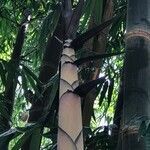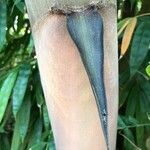Culms 6–10 m, 3–5 cm in diam., apically slightly drooping; internodes 30–36 cm, initially thinly white powdery; wall thick; nodes slightly prominent, basal 1 or 2 with rings of gray-white silky hairs below and above sheath scar; branching from base up. Branches several to many, clustered, central 3 dominant. Culm sheaths deciduous, convex and slanted along outer margin for 1/10–1/8 of length of sheath, with 1–3 pale yellow stripes toward outer margin, glabrous, apex asymmetrically arched; auricles unequal, outer one larger, ovate to ovate-elliptic, ca. 2.5 × 1–1.4 cm, slightly wrinkled; inner one smaller, ovate to elliptic, ascending, ca. 1/2 size of larger; oral setae slender, undulate; ligule 3–4 mm, laciniate, densely fimbriate; blade deciduous, erect, asymmetrically ovate-triangular to narrowly triangular, sparsely deciduously stiffly brown or pale brown strigose, base slightly rounded and then extending outward to join auricles for 5–7 mm, nearly 2/3–3/4 width of sheath apex, margin slightly wrinkled near base and fringed, apex subulate, acuminate. Leaf blade lanceolate to narrowly lanceolate, 10–18 × 1.5–2 cm, abaxially densely pubescent, adaxially glabrous or sparsely pilose near base. Pseudospikelets several at each node of flowering branches, pale green, linear-lanceolate, slightly flat, 2–3 × 0.3–0.4 cm; prophylls 2-keeled, keels ciliate, subtended by sheathlike bracts; gemmiferous bracts 2, glabrous, apex obtuse; florets 6 or 7, proximally and distally sterile; rachilla segments flat, 3–4 mm, apex inflated and cupular, hairy. Glume 1, ovate-oblong, ca. 8.5 mm, glabrous, apex acute; lemma ovate-oblong, 1.1–1.4 cm, ca. 19-veined, glabrous, apex obtuse, mucronate; palea about as long as or slightly shorter than lemma, 4-veined between and 4-veined on either side of keels, penicillate; lodicules 3, anterior 2 obovate, oblique, short, ca. 2.5 mm, broad, margins long ciliate; posterior one long, ca. 3 mm, narrow. Anthers ca. 3 mm, apex emarginate. Ovary obovoid, ca. 1.2 mm, stalked, apex thickened and hispid; style ca. 0.7 mm, hispid; stigmas 3, ca. 5.5 mm. Caryopsis terete, slightly curved, ca. 8 mm, ca. 1.5 mm in diam., apex obtuse and thickened, hispid, with remains of style.
More
A densely tufted bamboo. The culm or stem is erect but nodding at the tip. They grow 6-10 m tall. The stems are 3-5 cm across at the base. The young stems are covered with white wax. The internodes are 30-36 cm long. The lowest 1 or 2 nodes have a ring of grey silky hairs above the sheath scar. The stems branch from the nodes. The leaf blade is sword shaped and 10-18 cm long by 1-2 cm wide. Flowering can start at 50 years of age. In China clumps usually die after flowering but in other locations plants can remain alive.


